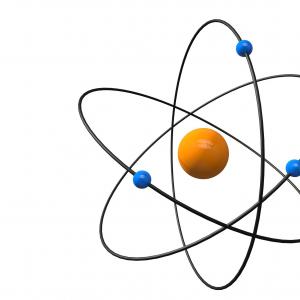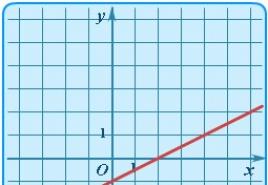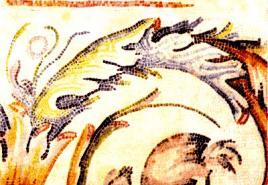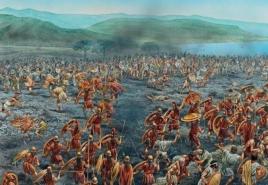Wed sv what. Heat capacity of gases
The ratio of the amount of heat received by a body with an infinitesimal change in its state to the associated change in body temperature is called heat capacity bodies in this process:
Typically, heat capacity is referred to a unit amount of a substance and, depending on the chosen unit, is distinguished:
specific mass heat capacityc , referred to 1 kg of gas,
J/(kg K);
specific volumetric heat capacityc´, referred to the amount of gas contained in 1 m 3 volume under normal physical conditions, J/(m 3 K);
specific molar heat capacity, referred to one kilomole, J/(kmol·K).
The relationship between specific heat capacities is established by obvious relationships: ;
Here is the gas density under normal conditions.
The change in body temperature with the same amount of heat imparted depends on the nature of the process occurring during this process, therefore heat capacity is a function of the process. This means that the same working fluid, depending on the process, requires a different amount of heat to heat it by 1 K. Numerically, the value of c varies from +∞ to -∞.
In thermodynamic calculations, the following are of great importance:
heat capacity at constant pressure
equal to the ratio of the amount of heat imparted to the body in a process at constant pressure to the change in body temperature dT
heat capacity at constant volume
equal to the ratio of the amount of heat , supplied to the body in the process at a constant volume, to a change in body temperature .
In accordance with the first law of thermodynamics for closed systems in which equilibrium processes occur ![]() , And
, And
For an isochoric process ( v=const) this equation takes the form ![]() , and, taking into account (1.5), we obtain that
, and, taking into account (1.5), we obtain that
![]() ,
,
that is, the heat capacity of a body at constant volume is equal to the partial derivative of its internal energy with respect to temperature and characterizes the rate of growth of internal energy in an isochoric process with increasing temperature.
For an ideal gas
For the isobaric process () from equation (2.16) and (2.14) we obtain
This equation shows the relationship between heat capacities with p And cv. For an ideal gas it is greatly simplified. Indeed, the internal energy of an ideal gas is determined only by its temperature and does not depend on volume, therefore, and in addition, it follows from the equation of state ![]() , where
, where
This relationship is called the Mayer equation and is one of the main ones in the technical thermodynamics of ideal gases.
In progress v=const the heat imparted to the gas goes only to change its internal energy, while in the process R= const heat is spent both to increase internal energy and to do work against external forces. That's why with p more cv on the amount of this work.
For real gases, since when they expand (at p=const) work is done not only against external forces, but also against the forces of attraction acting between molecules, which causes additional heat consumption.
Typically, heat capacities are determined experimentally, but for many substances they can be calculated using statistical physics methods.
The numerical value of the heat capacity of an ideal gas can be found by the classical theory of heat capacity, based on the theorem on the uniform distribution of energy over the degrees of freedom of molecules. According to this theorem, the internal energy of an ideal gas is directly proportional to the number of degrees of freedom of molecules and energy kT/2, per one degree of freedom. For 1 mole of gas
![]() ,
,
Where No- Avogadro's number; i- the number of degrees of freedom (the number of independent coordinates that must be specified in order to completely determine the position of the molecule in space).
A monatomic gas molecule has three degrees of freedom, corresponding to three components in the direction of the coordinate axes, into which translational motion can be decomposed. A diatomic gas molecule has five degrees of freedom, since in addition to translational motion, it can rotate about two axes perpendicular to the line connecting the atoms (the energy of rotation around the axis connecting the atoms is zero if the atoms are considered points). The molecule of a triatomic and generally polyatomic gas has six degrees of freedom: three translational and three rotational.
Since for an ideal gas ![]() , then the molar heat capacities of mono-, di- and polyatomic gases are equal, respectively:
, then the molar heat capacities of mono-, di- and polyatomic gases are equal, respectively:
![]() ;
;![]() ;
; ![]() .
.
The results of the classical theory of heat capacity are in fairly good agreement with experimental data in the room temperature region (Table 2.1), but the main conclusion about temperature independence is not confirmed by experiment. The discrepancies, especially significant in the region of low and fairly high temperatures, are associated with the quantum behavior of molecules and are explained within the framework of the quantum theory of heat capacity.
Heat capacity of some gases at t = 0°C in an ideal gas state
In addition to specific heat capacity, the concept of molar heat capacity is introduced, which is determined by the amount of thermal energy required to heat one mole of a substance by 1K.
Thus, if we denote the specific heat capacity by With, and the molar heat capacity through WITH, then it is obvious С = μс, where μ is the mass of one mole of a substance.
For gases, the specific heat capacity, as well as the molar heat capacity, depends on the conditions under which the gas is heated. The concept of two heat capacities is introduced: specific heat capacity at constant pressure with p and specific heat capacity at constant volume WithV.
Since the gas, when expanding, does work against the forces of external pressure, the specific heat capacity of the gas at constant pressure is greater than the specific heat capacity at constant volume. That is s p > WithV.
Difference of values s p - WithV for an ideal gas it is calculated theoretically: it is equal to the gas constant divided by the mass of one mole of the substance
An adiabatic process, in which there is no heat exchange between the gas and the environment, is described by the Poisson equation
where γ is the ratio of the specific heat capacity of an ideal gas at constant pressure to the specific heat capacity of the same gas at constant volume, that is
From theoretical considerations it follows that for a diatomic gas the ratio is 1.4. Experience shows that for diatomic gases, for example, hydrogen, oxygen, etc., as well as for air, this ratio is close to its theoretical value.
1. Description of the device and method
The device with which the ratio is determined consists of a cylinder B, a pressure gauge M, two taps K 1 and K 2 and a pump (Fig. 13).
Before starting work, there is a mass of air in the cylinder m, which, with valves K 1 and K 2 open, that is, at atmospheric pressure p 0, occupies volume V 0. Room temperature TK.
Using a pump, we pump a certain mass of air into the cylinder and close valve K1. The mass of air m that was in the cylinder is compressed, yielding part of the volume of the cylinder to a new portion of air. Now the mass of air occupies a volume less than the volume of the cylinder V 1< V 0 , давление внутри баллона возрастает до р 1 = р 0 +Δh 1 .
The contents of the cylinder became somewhat heated when an additional portion of air was pumped in. Due to adiabatic compression, the process proceeds quickly and heat exchange with the external environment does not have time to occur. Therefore, it is necessary to wait until the temperature in the cylinder becomes equal to TK and the level difference in the pressure gauge Δh 1 is established.
So, the first state of the air mass m is characterized by the parameters: p 1, V 1, T c.
р 1 = р 0 +Δh 1
We quickly open tap K2 and release air until the pressure inside the cylinder becomes equal to atmospheric p0, then close tap K2 again. Mass m will occupy the volume of the entire cylinder V 0, but since the process occurred very quickly, there was no heat exchange with the external environment, the temperature of the contents of the cylinder dropped to T 2< Т 0 , то есть имеет место адиабатическое расширение.
So, the second state of the gas is characterized by the following parameters:
p 2 = p 0 ; V 2 = V 0 ; T 2< Т К.
With valves K 1 and K 2 closed, wait a few minutes until the temperature rises to room temperature TK. As a result, the pressure inside the cylinder increases to
р 3 = р 0 +Δh 2
where Δh 2 is the difference in liquid levels in the pressure gauge.
The volume occupied by the mass m of air is equal to the volume of the cylinder V 3 = V 0 . The temperature became room temperature TK. The third state of air is characterized by the following parameters:
р 3 = р 0 +Δh 2 ; V 3 = V 0 ; T K.
So, the mass of air contained in the cylinder has passed through the following states:
I. р 1 = р 0 +Δh 1 ; V 1< V 0 ; Т К.
II. p 2 = p 0 ; V 2 = V 0 ; T 2< Т К.
III. р 3 = р 0 +Δh 3 ; V 3 = V 0 ; T K.
The transition from state I to state II is an adiabatic process. It satisfies the equation
(40)
The transition from state I to state III is isothermal. It satisfies the Boyle-Marriott equation
(41)
Let us transform equations (40) and (41)

but p 1 = p 0 +Δh 1, V 2 = V 3 = V 0, p 3 = p 0 +Δh 3, p 2 = p 0
 (42)
(42)
![]() (43)
(43)
We substitute in (42) instead of the ratio its value from (43), we get:

Taking logarithm of this equation, we have
![]()
Divide the numerator and denominator of the right side of the equation by p 0, then


from the theory of approximate calculations it is known that for small values of x:
(44)
Thus, by experimentally measuring and, we can determine the ratio of the specific heat capacities of air:
II. The order of work.
1. Close tap K 2 and open tap K 1. Pump air into the cylinder with a pump to a pressure corresponding to the difference in liquid levels Δh = 10 ÷ 15 cm, and close the tap.
2.Wait until the difference in levels in the pressure gauge is established, write down this difference.
3. Open tap K 2 and at the moment when the levels in the pressure gauge are equal, close it, without waiting for the fluid vibrations in the pressure gauge to stop.
4.Wait until the air in the cylinder, cooled by adiabatic expansion, warms up to room temperature. Write down this difference Δh 2.
5. Using the obtained values Δh 1 and Δh 2, calculate
6. Perform the experiment five times and, based on the data obtained, calculate the average value
7. Release the air from the cylinder by opening tap K 2 for a while.
8.Calculate the absolute and relative errors in determining γ
|
No. |
Δh 1 , mm |
Δh 2 , mm |
||
|
1 |
||||
|
2 |
||||
|
3 |
||||
|
4 |
||||
|
5 |
Control questions
1.What is heat capacity called? specific heat capacity? molar heat capacity? Write down the relationship between specific and molar heat capacities.
2. Define c p and c V, C p and C V. What does heat capacity depend on?
3. Derive Mayer’s equation (relationship between C p and C V).
4.Which is greater and why C r or C V?
5.Which process is called adiabatic. Write down the adiabatic equation. What and why is the adiabat or isotherm steeper?
6.Write the first law of thermodynamics for an adiabatic process. What are the amounts of heat, internal energy and work in an adiabatic process?
7.Derive the Poisson equation.
8.What is the adiabatic exponent? What does it depend on?
9. How many times and when does an adiabatic process occur in laboratory work?
10. Define entropy. Which parameter is constant during an adiabatic process? Write down the second law of thermodynamics.
11.Which process is called cyclic? Carnot cycle. Efficiency of the Carnot cycle. At what parts of the Carnot cycle is heat supplied and taken away, and at what parts is work done by the gas and on the gas?
Specific heat capacity of a substance- a value equal to the amount of heat required to heat 1 kg of a substance by 1 K:
The unit of specific heat capacity is joule per kilogram kelvin (J/(kg K)).
Molar heat capacity- a value equal to the amount of heat required to heat 1 mole of a substance by 1 K:
Where ν =m/M is the amount of substance.
The unit of molar heat capacity is joule per mole kelvin (J/(mol K)).
The specific heat capacity c is related to the molar heat capacity C m, the relation
where M is the molar mass of the substance.
Heat capacities are identified at constant volume and constant pressure if, during the process of heating a substance, its volume or pressure is maintained constant. Let us write down the expression of the first law of thermodynamics for one mole of gas, taking into account (1) and δA=pdV
If the gas is heated at a constant volume, then dV = 0 and the work of external forces is also zero. Then the heat imparted to the gas from the outside only goes to increase its internal energy:
(4) i.e., the molar heat capacity of a gas at a constant volume C V is equal to the change in the internal energy of one mole of gas with an increase in its temperature by 1 K. Since U m =( i/2)RT ,
If the gas is heated at constant pressure, then expression (3) can be represented in the form
Considering that (U m / dT) does not depend on the type of process (the internal energy of an ideal gas does not depend on either p or V, but is determined only by temperature T) and is always equal to C V, and differentiating the Clapeyron-Mendeleev equation pV m = RT by T (p=const), we get
Expression (6) is called Mayer's equation; it says that C p is always greater than C V exactly by the molar gas constant. This is explained by the fact that in order to heat a gas at a constant pressure, an additional amount of heat is required to perform the work of expansion of the gas, since the constancy of the pressure is ensured by an increase in the volume of the gas. Using (5), formula (6) can be written as
When studying thermodynamic processes, it is important to know the characteristic ratio of C p to C V for each gas:
![]() (8)
(8)
called adiabatic index. From the molecular kinetic theory of ideal gases, the numerical values of the adiabatic exponent are known; they depend on the number of atoms in the gas molecule:
Monatomic gas γ = 1,67;
Diatomic gas γ = 1,4;
Tri- and polyatomic gas γ = 1,33.
(The adiabatic exponent is also denoted by k)
11. Warmth. The first law of thermodynamics.
The internal energy of a thermodynamic system can change in two ways: through work done on the system and through heat exchange with the environment. The energy that a body receives or loses in the process of heat exchange with the environment is called amount of heat or simply warmth.
The unit of measurement in (SI) is joule. The calorie is also used as a unit of heat measurement.
The first law of thermodynamics is one of the basic principles of thermodynamics, which is essentially the law of conservation of energy as applied to thermodynamic processes.
The first law of thermodynamics was formulated in the middle of the 19th century as a result of the work of J. R. Mayer, Joule and G. Helmholtz. The first law of thermodynamics is often formulated as the impossibility of the existence of a perpetual motion machine of the 1st kind, which would do work without drawing energy from any source.
Formulation
The amount of heat received by the system goes to change its internal energy and perform work against external forces.
The first law of thermodynamics can be formulated as follows:
“The change in the total energy of the system in a quasi-static process is equal to the amount of heat Q imparted to the system, in sum with the change in energy associated with the amount of substance N at the chemical potential, and the work A” performed on the system by external forces and fields, minus the work A performed the system itself against external forces":
For an elementary amount of heat, elementary work, and a small increment (total differential) of internal energy, the first law of thermodynamics has the form:
Dividing the work into two parts, one of which describes the work done on the system, and the second - the work done by the system itself, emphasizes that these works can be done by forces of different nature due to different sources of forces.
It is important to note that and are complete differentials and and are not. The heat increment is often expressed in terms of temperature and entropy increment: .
Where A– atomic mass; m units- atomic mass unit; N A- Avogadro's number; mol μ – the amount of a substance that contains a number of molecules equal to the number of atoms in 12 g of the carbon isotope 12 C.
The heat capacity of a thermodynamic system depends on how the state of the system changes when heated.
If the gas is heated at constant volume, then all the heat supplied goes to heating the gas, that is, changing its internal energy. The heat capacity is then denoted C V.
S R– heat capacity at constant pressure. If you heat a gas at constant pressure R in a vessel with a piston, then the piston will rise to a certain height h, that is, the gas will do work (Fig. 4.2).

Rice. 4.2
Consequently, conducted heat is spent both on heating and on doing work. From this it is clear that .
So, conducted heat and heat capacity depend on how heat is transferred. Means, Q And C are not state functions.
Quantities S R And C V turn out to be connected by simple relations. Let's find them.
Let us heat one mole of an ideal gas at constant volume (d A= 0). Then we write the first law of thermodynamics in the form:
| , | (4.2.3) |
Those. an infinitesimal increase in the amount of heat is equal to the increase in internal energy d U.
Heat capacity at constant volume will be equal to:
Because U may depend not only on temperature. But in the case of an ideal gas, formula (4.2.4) is valid.
From (4.2.4) it follows that
 , ,
|
During an isobaric process, in addition to an increase in internal energy, work is performed by the gas:
| . |
An ideal gas is a mathematical model of a gas in which the potential energy of the molecules is assumed to be negligible compared to their kinetic energy. There are no forces of attraction or repulsion between molecules, collisions of particles with each other and with the walls of the vessel are absolutely elastic, and the interaction time between molecules is negligible compared to the average time between collisions.
2. What are the degrees of freedom of molecules? How is the number of degrees of freedom related to Poisson's ratio γ?
The number of degrees of freedom of a body is the number of independent coordinates that must be specified in order to completely determine the position of the body in space. For example, a material point moving arbitrarily in space has three degrees of freedom (coordinates x, y, z).
Molecules of a monatomic gas can be considered as material points on the grounds that the mass of such a particle (atom) is concentrated in a nucleus whose dimensions are very small (10 -13 cm). Therefore, a monatomic gas molecule can have only three degrees of freedom of translational motion.
Molecules consisting of two, three or more atoms cannot be likened to material points. A diatomic gas molecule, to a first approximation, consists of two tightly bound atoms located at some distance from each other
3. What is the heat capacity of an ideal gas during an adiabatic process?
Heat capacity is a value equal to the amount of heat that must be imparted to a substance to increase its temperature by one kelvin.
4. In what units are pressure, volume, temperature, and molar heat capacities measured in the SI system?
Pressure – kPa, volume – dm 3, temperature – in Kelvin, molar heat capacities – J/(molK)
5. What are the molar heat capacities Cp and Cv?
A gas has a heat capacity at constant volume Cv and heat capacity at constant pressure Cr.
At a constant volume, the work of external forces is zero, and the entire amount of heat imparted to the gas from the outside goes entirely to increasing its internal energy U. Hence, the molar heat capacity of a gas at a constant volume C v is numerically equal to the change in the internal energy of one mole of gas ∆U when its temperature increases by 1 K:
∆U=i/2*R(T+1)-i/2RT=i/2R
Thus, the molar heat capacity of a gas at constant volume
WITH v=i/2R
specific heat capacity at constant volume
WITH v=i/2*R/µ
When a gas is heated at constant pressure, the gas expands; the amount of heat imparted to it from the outside goes not only to increase its internal energy U, but also to perform work A against external forces. Consequently, the heat capacity of a gas at constant pressure is greater than the heat capacity at constant volume by the amount of work A performed by one mole of gas during expansion resulting from an increase in its temperature by 1 K at constant pressure P:
C p = WITH v+A
It can be shown that for a mole of gas the work is A=R, then
C p = WITH v+R=(i+2)/2*R
Using the relationship between specific and molar heat capacities, we find for the specific heat capacity:
C p = (i+2)/2*R
Direct measurement of specific and molar heat capacities is difficult, since the heat capacity of the gas will be a tiny fraction of the heat capacity of the container in which the gas is located, and therefore the measurement will be extremely inaccurate.
It is easier to measure the ratio of greatness C p / WITH v
γ=C p / WITH v=(i+2)/i.
This ratio depends only on the number of degrees of freedom of the molecules that make up the gas.







